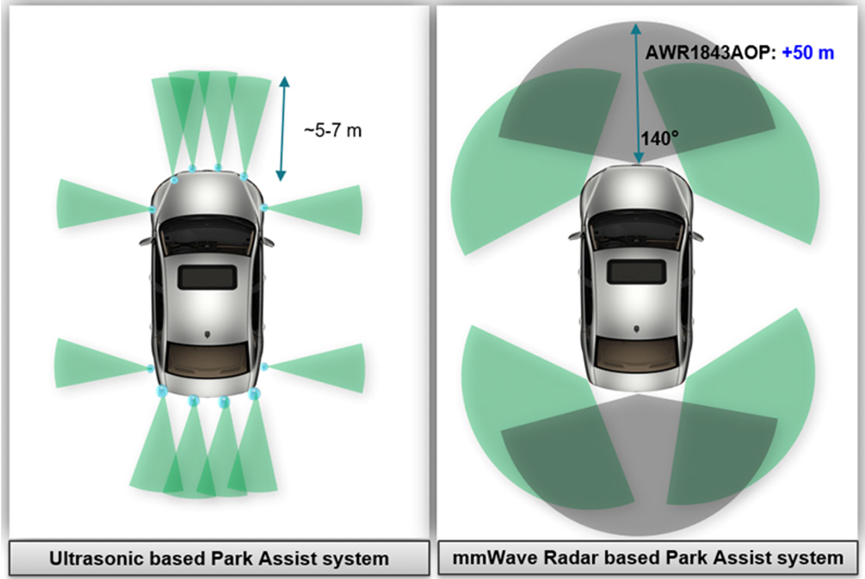Author: Zhu Yulong
In the past 20 years, millimeter-wave radar has established itself as a sensor technology solution in the automotive industry.
When millimeter-wave radar first appeared on the market, it was offered as an option only on luxury cars (similar to what infrared night vision systems are today). However, now that millimeter-wave radar is bundled with crucial assisted driving safety features, it has become synonymous with active safety for automobiles. As the automotive industry moves towards intelligence and automation, the advantages of radar over other types of sensors make it applicable to a wider range of use cases.
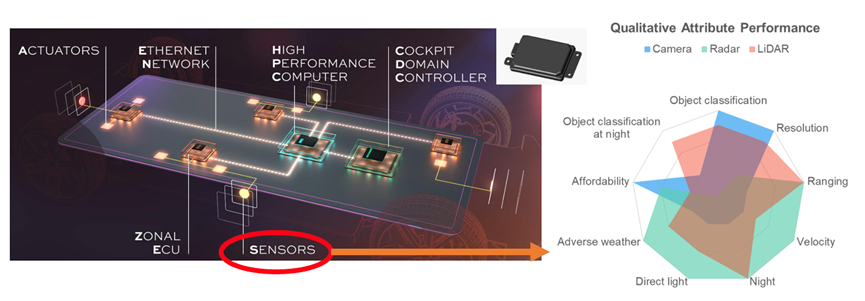
Semiconductor companies are speeding up the deployment of millimeter-wave radar with CMOS-based single-chip solutions in mass production. On the one hand, single-chip integration lowers the R&D barriers for the entire 77 GHz radar system, while on the other hand, it significantly improves the product’s qualification rate and reduces costs.
The high integration of single-chip systems enables multi-sensor fusion calculations of target position, speed and other information, which also accelerates the use of millimeter-wave radar in the automotive and industrial fields. Its 77GHz 4D radar can be as small as a matchbox, half the size of traditional millimeter-wave radars (ABCD Autoliv, Bosch, Continental, and Delphi). The long-distance radar ranging can reach up to 250 meters, with angular resolution less than 3 degrees and outstanding pedestrian and bicycle detection capabilities. The production price can also make traditional millimeter-wave radars more affordable.
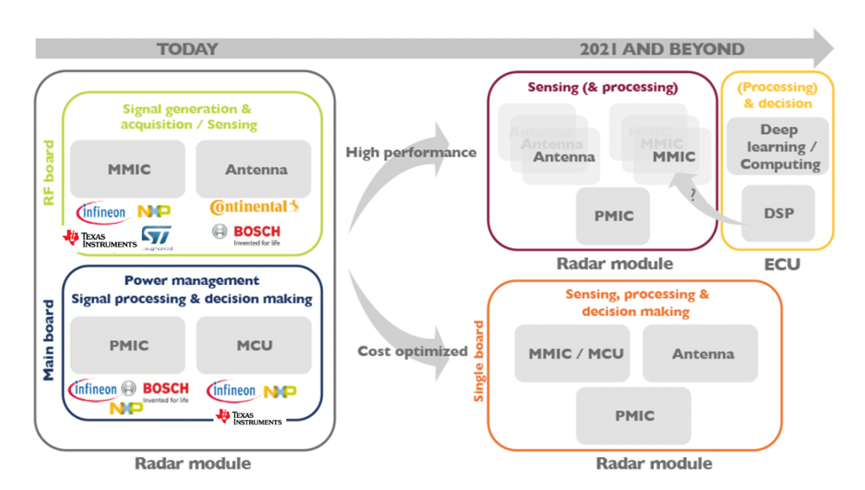
Millimeter-Wave Radar Used in Autonomous Driving
The operating frequency range of millimeter-wave radar is generally between 30GHz-300GHz, with wavelengths ranging between microwaves and centimeter waves (1mm-10mm). Currently, commercially mature vehicle-mounted millimeter-wave radars include 24GHz (MRR, short-to-medium-range radar) and 77GHz (LRR, long-range radar), with the latter being small in size, low in power consumption, high in bandwidth, good in resolution, and having a long detection range.### 24GHz MRR Detection Distance Within 70 Meters
The 24GHz MRR detection distance is within 70 meters, which is suitable for blind spot monitoring (BSD), lane changing assistance, automatic emergency braking (AEB), and other scenarios. The “Interim Provisions on Radio Management of Automotive Radar” issued by the Ministry of Industry and Information Technology in December 2021 states that “the 76GHz-79GHz frequency band is planned for automotive radar to promote the application of intelligent automotive technology and industrial development.” Starting from March 1, 2022, “the application for approval of wireless transmission equipment models of 24.25GHz-26.65GHz frequency band automotive radar will no longer be accepted or reviewed.” The 77GHz LRR detection distance is hundreds of meters and is mainly used in adaptive cruise control, automatic emergency braking, forward collision warning (FCW) and other scenarios.
As autonomous driving continues to evolve into higher levels, the autonomous driving perception system demands high accuracy and reliability in perception, while also requiring the sensors to work “24/7,” detect objects from a longer distance, and provide more precise perception information.
Many global automakers have started to equip their vehicles with five millimeter-wave radars, and may potentially equip eight in the future. Many perception schemes use cameras and millimeter-wave radars for data fusion, from traditional post-fusion, result-fusion, to mixed fusion and front-end fusion.
With the reduction of the cost of millimeter-wave radars and the integration of driving and parking, the role of millimeter-wave in parking is more significant than that of traditional ultrasound sensors, with the following advantages:
(1) Longer Detection Range
By sensing objects from a further distance, more objects near the parking area can be detected. Taking TI’s AWR1843AOP as an example, objects as far as 50 meters away can be detected.
(2) More Accurate Object Detection
The minimum detection range of traditional ultrasound sensors is about 10-15 centimeters. AWR1843AOP can detect objects as close as 4 centimeters, which can help the parking system work in narrow and compact parking spaces. At the same time, it can also detect curbs close to the vehicle to improve the success rate of parking. Figure 4 shows the ability of millimeter-wave radar to distinguish different sizes and materials of objects (including wood, metal, and plastic) in an experimental scenario, including plastic road cones, hand carts, wooden stakes, and metal stakes.
(3) Wider Coverage Area
Compared with ultrasound sensors (which can usually have up to 12), the coverage area of millimeter-wave radar is wider, and it can achieve 360-degree coverage ability together with vision. The 140-degree vertical field of view of AWR1843AOP can detect low-lying objects, such as stones on road curbs, pets, and various strange things in parking lots. The wide field of view and high range resolution can detect and distinguish multiple static objects simultaneously.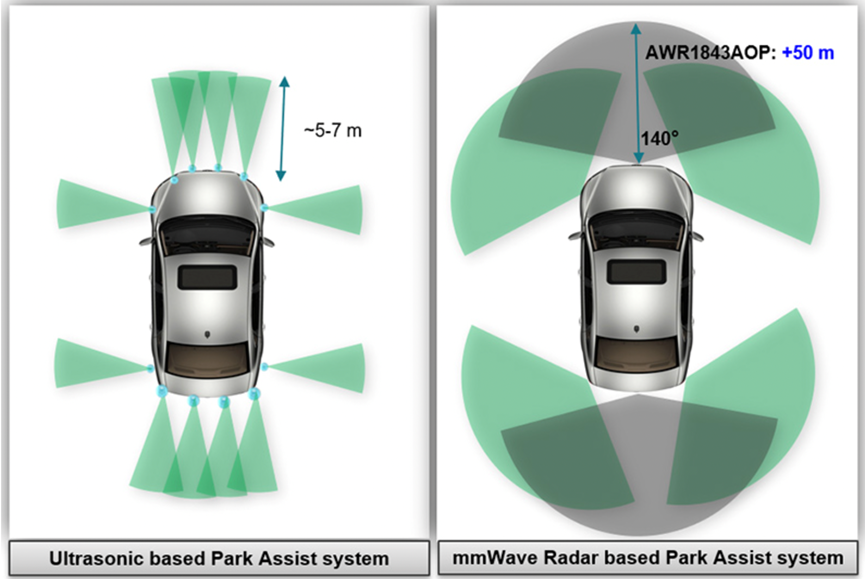
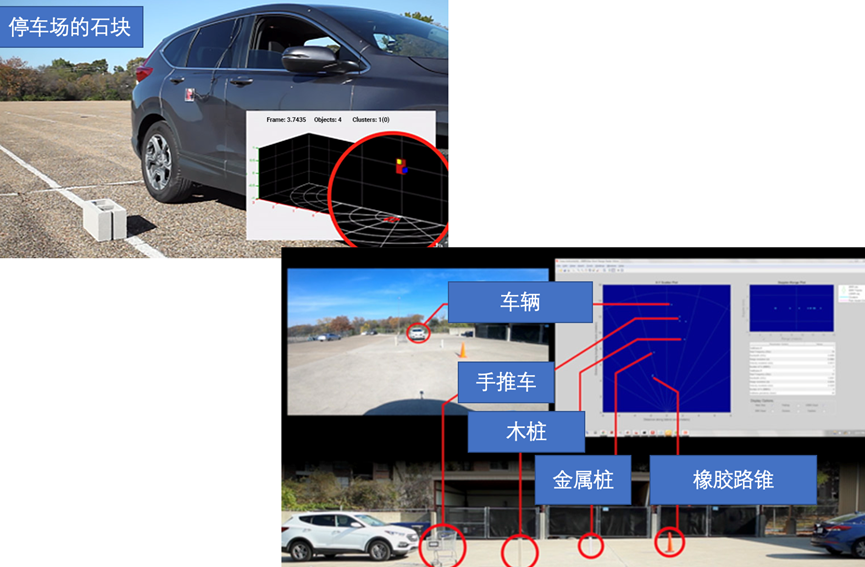
Millimeter-wave Detection in Cabin
Gesture detection is becoming popular in cabin technology, which provides a new way of interaction to control the temperature, lighting, windows, intelligent cabin system, etc. with just a wave of your hand.
To achieve this, time-of-flight (ToF) sensors or cameras can be used, and also millimeter-wave radar can be used as a multifunctional sensor for gesture control and interior sensing. It can detect various gestures, such as waving from left to right, from right to left, from top to bottom, and from bottom to top. TI’s AWR6843AOP millimeter-wave sensor can achieve high-precision gesture detection and can be flexibly placed anywhere in the vehicle (top console or cabin instrument).
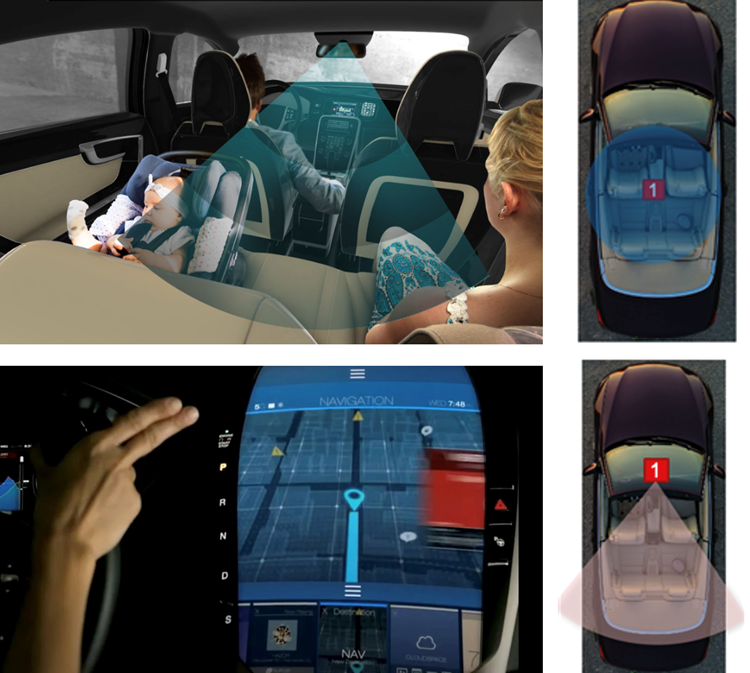
One of the characteristics of millimeter-wave sensors is that they can operate under different lighting conditions (cameras may report incorrectly under direct sunlight), and provide data parameters such as distance, angle, and velocity in the vehicle through 3D point cloud information. All the multi-modal functions are integrated on a single chip. TI’s intelligent integrated millimeter-wave chip allows the millimeter-wave radar to have independent functions and be used together with the entire intelligent cabin.
When the car is parked and the main system is shut down, the millimeter-wave sensor can be in a low power consumption state to provide child or intrusion detection in the car.
When the car is in normal driving status, the sensor can perform gesture detection.
The benefit of this approach is to simplify the configuration of interior sensors and achieve flexible interior layout (wide field of view and the ability to sense millimeter-wave penetration materials). Depending on the application, sensors can be integrated into the dashboard, top console, even the second or third row seat, to achieve more personalized applications (such as lighting, entertainment screens, or passenger temperature and audio adjustment).
In summary, millimeter-wave radar was first used in military applications and gradually applied to advanced driving assistance systems and autonomous driving due to its advantages of accurate sensing and not easily influenced by interference. As a contactless sensing technology, millimeter-wave radar sensors have now been widely used in the automotive industry.With the increasing demand and development of automation in the industrial and consumer fields, the application scope of millimeter-wave radar is expanding beyond the automotive field, gradually extending to industries such as smart cities, building automation, and health monitoring. In particular, the emergence of integrated millimeter-wave radar modules enables semiconductor enterprises of millimeter-wave radar chips to promote the advancement of the entire industrial chain.
This article is a translation by ChatGPT of a Chinese report from 42HOW. If you have any questions about it, please email bd@42how.com.
